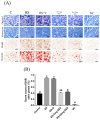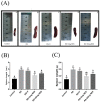Resveratrol Protects against Restraint Stress Effects on Stomach and Spleen in Adult Male Mice
- PMID: 31569722
- PMCID: PMC6826970
- DOI: 10.3390/ani9100736
Resveratrol Protects against Restraint Stress Effects on Stomach and Spleen in Adult Male Mice
Abstract
The objectives were to investigate whether restraint stress (which is known as a mixture of psychologic and physical stress) exerts negative effects on the stomach and spleen, and whether the phenolic compound resveratrol (RES) exerts any protective roles. Fifty adult male mice were divided into five groups, with 10 mice per group as follows: control (C), restraint stress (RS), RS with vehicle (RS + V), RS with 2 mg/kg of resveratrol (RS + 2 mg RES), and RS with 20 mg/kg of resveratrol (RS + 20 mg RES). Mice were restrained in conical centrifuge tubes for 4 h daily to establish the RS model. RS + 2 mg RES, RS + 20 mg RES, and RS + V groups were given an oral dose of resveratrol or vehicle for 15 consecutive days, while the control group was not exposed to restraint stress. Herein, we showed that restraint stress decreased body weight and food and water consumption in stressed groups RS and RS + V compared to controls, while the groups treated with resveratrol showed improvements. Moreover, restraint stress caused acute damage to the morphology of gastric cells and reduced the quantitative distribution of parietal cells along with their decreased size and diameter, pointing to gastritis or ulcer. Furthermore, the antibody against the apoptosis-inducing factor (AIF) was highly attached in the RS groups. Splenic size, weight, and length were also greatly augmented in the stressed groups compared to the controls, while these phenomena were not observed in the RS + 2 mg RES group. Our findings proved significant ameliorating effects of resveratrol against restraint stress in adult male mice.
Keywords: DAB intensity; apoptosis-inducing factor; parietal cells; restraint stress; resveratrol; splenomegaly.
Conflict of interest statement
The authors declare no conflict of interest. The funders had no role in the design of the study; in the collection, analyses, or interpretation of the data; in the writing of the manuscript; or in the discussion to publish the results.
Figures









Similar articles
-
Resveratrol Ameliorates Testicular Histopathology of Mice Exposed to Restraint Stress.Animals (Basel). 2019 Sep 29;9(10):743. doi: 10.3390/ani9100743. Animals (Basel). 2019. PMID: 31569470 Free PMC article.
-
Positive Roles of Resveratrol in Early Development of Testicular Germ Cells against Maternal Restraint Stress in Mice.Animals (Basel). 2020 Jan 12;10(1):122. doi: 10.3390/ani10010122. Animals (Basel). 2020. PMID: 31940890 Free PMC article.
-
Autophagy is involved in the effects of resveratrol on prevention of splenocyte apoptosis caused by oxidative stress in restrained mice.Mol Nutr Food Res. 2013 Jul;57(7):1145-57. doi: 10.1002/mnfr.201200662. Epub 2013 Mar 15. Mol Nutr Food Res. 2013. PMID: 23505001
-
Protective roles of Rutin against restraint stress on spermatogenesis in testes of adult mice.Tissue Cell. 2018 Feb;50:133-143. doi: 10.1016/j.tice.2018.01.003. Epub 2018 Jan 10. Tissue Cell. 2018. PMID: 29429513
-
Resveratrol improves sperm parameter and testicular apoptosis in cisplatin-treated rats: Effects on ERK1/2, JNK, and Akt pathways.Syst Biol Reprod Med. 2019 Jun;65(3):236-249. doi: 10.1080/19396368.2018.1541114. Epub 2018 Dec 3. Syst Biol Reprod Med. 2019. PMID: 30507263
Cited by
-
Maternal oral sodium propionate supplementation restores gut integrity and mitigates stress-induced metabolic and behavioral outcomes in offspring.Transl Psychiatry. 2025 Jul 9;15(1):235. doi: 10.1038/s41398-025-03436-x. Transl Psychiatry. 2025. PMID: 40634281 Free PMC article.
-
The Synergistic Effects of the Combination of L-Carnitine and Lycopene on the Lycopene Bioavailability and Duodenal Health of Roosters.Animals (Basel). 2023 Apr 7;13(8):1274. doi: 10.3390/ani13081274. Animals (Basel). 2023. PMID: 37106837 Free PMC article.
-
Effects of chronic restraint stress in the prostate of prepubertal and adult rats.Acta Cir Bras. 2023 Dec 4;38:e387123. doi: 10.1590/acb387123. eCollection 2023. Acta Cir Bras. 2023. PMID: 38055386 Free PMC article.
-
The effects of curcumin and sertraline on stress-induced changes in the stomach tissues of rats.Naunyn Schmiedebergs Arch Pharmacol. 2023 Sep;396(9):2057-2069. doi: 10.1007/s00210-023-02453-1. Epub 2023 Mar 14. Naunyn Schmiedebergs Arch Pharmacol. 2023. PMID: 36917242
-
Natural products for Gut-X axis: pharmacology, toxicology and microbiology in mycotoxin-caused diseases.Front Pharmacol. 2024 Jun 19;15:1419844. doi: 10.3389/fphar.2024.1419844. eCollection 2024. Front Pharmacol. 2024. PMID: 38978980 Free PMC article. Review.
References
Grants and funding
LinkOut - more resources
Full Text Sources

